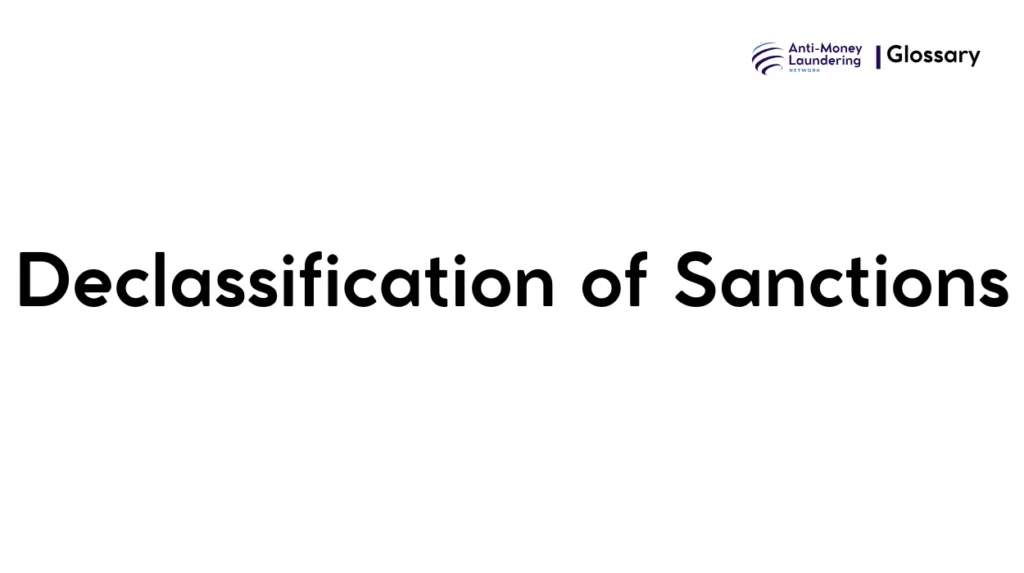Definition
Declassification of Sanctions in the AML context refers to the formal process by which an individual, entity, or transaction previously subject to financial sanctions is officially removed or relieved from such restrictions. This process acknowledges that the risks or reasons for prior sanctions no longer apply, thereby lifting the prohibitions that were originally imposed under AML and sanctions frameworks.
Purpose and Regulatory Basis
The purpose of declassification is to ensure that sanctions regimes remain accurate, relevant, and just, reflecting the current risk profile and status of parties involved. Financial sanctions are a critical AML tool used to prevent money laundering, terrorist financing, and other illicit activities. Declassification helps balance effective enforcement with the rights of individuals and entities when the underlying threat or justification for sanctioning has been mitigated or removed.
Key regulatory frameworks that govern sanctions and their declassification include:
- The Financial Action Task Force (FATF), which sets international AML standards emphasizing ongoing risk assessment.
- The USA PATRIOT Act, which incorporates provisions on sanctions screening and compliance.
- The European Union’s Anti-Money Laundering Directives (AMLD), which outline sanctions enforcement and compliance obligations.
- National Acts, such as the UK Sanctions and Anti-Money Laundering Act 2018, detailing the legal basis for sanction imposition and removal.
When and How it Applies
Declassification is applied when:
- An individual or entity’s sanction status changes due to geopolitical shifts or legal review.
- A politically exposed person (PEP) steps down from office and after a risk reassessment, is no longer classified as high risk.
- Legal appeals or changes in policy result in removal from sanction lists.
Example scenarios include:
- A foreign government lifting economic sanctions after diplomatic agreements.
- Reassessment of former PEPs after a statutory period, typically 12-18 months post-office.
Types or Variants
There are various forms of declassification depending on sanction types:
- Full Declassification: Complete removal from all sanction lists and restrictions.
- Partial Declassification: Removal from some but not all sanction measures, e.g., lifting financial restrictions but maintaining trade bans.
- PEP Declassification: Re-classifying a former politically exposed person as a lower-risk client based on decreased influence.
Procedures and Implementation
Financial institutions should incorporate the following steps:
- Monitoring and Review: Continuous scanning against updated sanctions lists.
- Risk Assessment: Evaluate if conditions for declassification have been met.
- Documentation: Maintain full records supporting declassification decisions.
- Formal Removal Process: Follow regulatory or authority procedures to effect removal.
- System Updates: Adjust internal systems and controls to reflect declassification.
- Staff Training: Educate employees about declassification criteria and handling.
Automation and integration with sanctions screening tools enhance accuracy and timeliness.
Impact on Customers/Clients
From the customer perspective, declassification may:
- Restore access to banking services and transactions previously blocked.
- Remove reputational restrictions and compliance burdens.
- Require ongoing monitoring despite declassification to guard against reinstatement.
Clients should be informed transparently about their status and any new compliance requirements.
Duration, Review, and Resolution
Declassification timeframes depend on regulatory guidance:
- Typically follows a statutory waiting period (e.g., 12-18 months after office for PEPs).
- Requires periodic reviews to confirm ongoing low risk.
- Institutions must retain obligations to reassess if circumstances change.
Resolution usually concludes with formal notification to all stakeholders and system updates.
Reporting and Compliance Duties
Institutions are responsible for:
- Accurately reporting declassifications in compliance documentation.
- Updating customer risk profiles and AML records.
- Ensuring adherence to supervisory authority requirements.
- Training staff on declassification implications and compliance.
Failure to properly manage declassification can lead to regulatory sanctions, fines, or reputational damage.
Related AML Terms
- Financial Sanctions: Restrictions on funds or transactions involving listed parties.
- Politically Exposed Persons (PEPs): Individuals with prominent public functions subject to enhanced due diligence.
- Sanctions Screening: The process of checking parties against sanctions lists.
- Risk Assessment: Evaluating money laundering and terrorism financing risks.
Challenges and Best Practices
Common challenges include:
- Lack of uniform declassification criteria internationally.
- Delays in sanction list updates causing compliance gaps.
- Balancing regulatory obligations with client rights.
Best practices involve:
- Implementing automated sanctions screening systems.
- Establishing clear policies and documented processes for declassification.
- Continuous training and awareness for compliance teams.
- Coordinating with regulators and legal advisors to ensure up-to-date adherence.
Recent Developments
- Growing use of AI and machine learning to assist in dynamic risk scoring and declassification decisions.
- Increased regulatory focus on timely updates of sanction lists.
- Enhanced transparency requirements around PEP status changes and sanction removals.
Declassification of sanctions is a crucial AML process that ensures sanctions remain fair and relevant, balancing enforcement with justified relief. For compliance officers and financial institutions, robust procedures, clear policies, and ongoing risk assessment are essential to manage declassification effectively while safeguarding financial system integrity.

